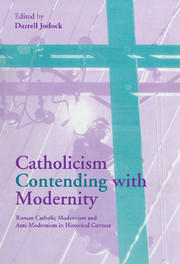 Catholicism Contending with Modernity
Catholicism Contending with Modernity Published online by Cambridge University Press: 30 October 2009
Of the various settings or contexts that shaped the Modernist crisis in Roman Catholicism a century ago, none was closer to the bone of the protagonists than church life itself. The Modernists were, after all, engaged in what they saw as a necessary church reform movement. Their concern was with the intellectual vigor of Catholicism in the modern world. The most conspicuous element in their immediate church context was the “obscurantism” (Wilfrid Ward) that they ran up against in infuential circles. The degree to which it gained the upper hand, making a crisis out of a controversy, requires explanation.
After all, the Modernists' pursuits were predominantly “academic.” They scarcely touched upon the burning issues of church and state that preoccupied bishops and curial officials. Moreover, Pope Leo XIII (pope from 1878 to 1903) was calling for a renewal of ecclesiastical studies to bring them up to par with the challenges of the modern world. In these circumstances, reform-minded scholars who were ecclesiastics could well have expected some elbowroom for revising conventional positions. The mobilization of anti-Modernism was so effective, nevertheless, that a full battery of papal condemnations was loosed upon them in the pontificate of Pius X (1903–1914), especially from 1907 onwards. Where did this anti-Modernism come from? What were its sources of strength within the Catholic communion?
To save this book to your Kindle, first ensure [email protected] is added to your Approved Personal Document E-mail List under your Personal Document Settings on the Manage Your Content and Devices page of your Amazon account. Then enter the ‘name’ part of your Kindle email address below. Find out more about saving to your Kindle.
Note you can select to save to either the @free.kindle.com or @kindle.com variations. ‘@free.kindle.com’ emails are free but can only be saved to your device when it is connected to wi-fi. ‘@kindle.com’ emails can be delivered even when you are not connected to wi-fi, but note that service fees apply.
Find out more about the Kindle Personal Document Service.
To save content items to your account, please confirm that you agree to abide by our usage policies. If this is the first time you use this feature, you will be asked to authorise Cambridge Core to connect with your account. Find out more about saving content to Dropbox.
To save content items to your account, please confirm that you agree to abide by our usage policies. If this is the first time you use this feature, you will be asked to authorise Cambridge Core to connect with your account. Find out more about saving content to Google Drive.